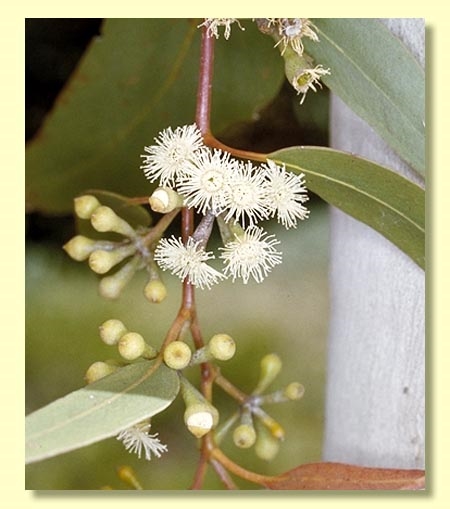Euclid - Online edition
Eucalyptus haemastoma
Eucalyptus | Eucalyptus | Cineraceae | Psathyroxylon | Haemastomae
Bark smooth, white, grey, yellow or silvery grey, with prominent scribbles.
Juvenile stem rounded in cross-section, warty on lower internodes; juvenile leaves opposite for 5 or 6 pairs, sessile or shortly petiolate, elliptic to oblong, becoming alternate, petiolate, obliquely ovate, 7–15 cm long, 2–6 cm wide, base tapering, rounded or oblique, concolorous, dull, blue-green.
Adult leaves alternate, petiole 1.2–2 cm long; blade broadly lanceolate to lanceolate or falcate, 9–21 cm long, 1.5–3.5 cm wide, base oblique, concolorous, slightly glossy to dull, green, side-veins acute, sparsely reticulate, intramarginal vein parallel to and remote from margin, oil glands mostly island.
Inflorescence axillary unbranched, peduncles 0.5–2.5 cm long, buds 9 to 15 per umbel, pedicels 0.3–0.7 cm long. Mature buds obovoid, 0.4–0.6 cm long, 0.3–0.4 cm wide, green to yellow, scar absent, operculum conical to rounded, stamens inflexed, with a few outer staminodes, anthers reniform to cordate, versatile, dorsifixed, dehiscing by confluent slits, style short, stigma tapered, locules 3 or 4, the placentae each with 2 vertical ovule rows. Flowers white.
Fruit pedicellate (pedicels 0.2–0.7 cm long), obconical to hemispherical or truncate-globose, 0.5–0.9 cm long, 0.7–1.1 cm wide, disc raised-convex, or level, valves 3 or 4, near rim level.
Seeds brown, 1.5–3 mm long, pyramidal or obliquely pyramidal, dorsal surface smooth, hilum terminal.
Cultivated seedlings (measured at ca node 10): cotyledons reniform; stems rounded in cross-section, warty to scabrid in lower part; leaves subsessile to shortly petiolate and opposite for 5 or 6 nodes, becoming petiolate, alternate, broadly lanceolate to falcate, 8.5–15 cm long, 2.5–6 cm wide, base usually rounded to tapering but upper leaves oblique, margin entire, apex pointed, dull, more or less concolorous, blue-green to green.
Flowering has been recorded in July, August, September and November.
A small to medium-sized tree, it is one of three scribbly-gum species. These are notable for the completely smooth bark with insect scribbles. Eucalyptus haemastoma is of restricted distribution on poor sandstone-derived soils around Sydney, New South Wales. The newly exposed bark in summer is often spectacularly yellow becoming white with age, flower buds are club-shaped and fruit usually hemispherical and flat-topped.
E. haemastoma differs from the related scribbly-gums E. racemosa subsp. rossii and E. racemosa subsp. racemosa by the larger buds and fruits, and is further separated from E. racemosa subsp. rossii by the broadly ovate juvenile leaves.
Eucalyptus haemastoma belongs in Eucalyptus subgenus Eucalyptus section Cineraceae series Psathyroxylon having the following characters: cotyledons reniform, juvenile leaves alternate, bluish, adult leaves with side-veins acute, single axillary inflorescences with buds in clusters of nine to 15, buds with single operculum, inflexed stamens, some outer stamens without anthers (staminodes), the remainder with reniform anthers, style short, ovules in two rows, and seeds more or less pyramidal. Within series Psathyroxylon the three scribbly gums E. haemastoma, E. racemosa subsp. rossii and E. racemosa subsp. racemosa form subseries Haemastomae.














